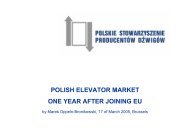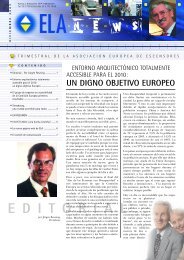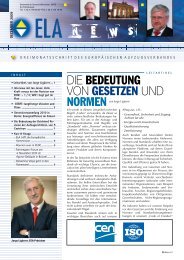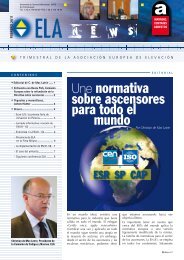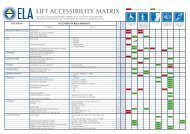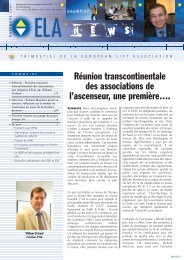WP6-Brochure-E4 brochure - ELA European Lift Association.
WP6-Brochure-E4 brochure - ELA European Lift Association.
WP6-Brochure-E4 brochure - ELA European Lift Association.
Create successful ePaper yourself
Turn your PDF publications into a flip-book with our unique Google optimized e-Paper software.
6 Estimation of Potential Savings<br />
This chapter presents the results of the estimation of the electricity consumption of existing<br />
lifts and escalators in Europe, as well as of the savings potential made possible by the use of<br />
the best available technologies in the market today.<br />
The characterisation of the installed base according to building type and basic characteristics<br />
was made, as part of Work Package 2, by means of a survey conducted in cooperation with the<br />
national member associations of the <strong>European</strong> <strong>Lift</strong> <strong>Association</strong> (<strong>ELA</strong>, presented in chapter 4).<br />
Typical values for the electricity consumption of lifts are based on the monitoring campaign<br />
carried out during this project (Work Package 3), in a number of selected buildings of the<br />
residential, tertiary and industrial sectors, taking into consideration typical lift and escalator<br />
technologies in use. A total of 81 equipments have been measured by the project’s partners<br />
(ENEA, Fraunhofer‐ISI, KAPE and ISR‐UC) in the four countries concerned: Italy, Germany,<br />
Poland, and Portugal.<br />
With respect to the achieved values of potential savings, it is important to notice that:<br />
• The initial cost of the technologies used, while being an important issue regarding their<br />
application, has not been considered in this report; therefore, no indications are<br />
provided about cost‐effectiveness of those technologies;<br />
• Maintenance costs, such as labour and spare‐parts, have not been included in the<br />
calculations, even if some of the electronic components in inverters (e.g. cooling fans,<br />
capacitors, internal relays) ought to be periodically serviced in order to avoid<br />
degradation in the inverter’s performance;<br />
• Some technologies may increase stand‐by consumption while reducing consumption<br />
during the running phase. Therefore, their application should be carefully evaluated on<br />
a specific‐case basis.<br />
6.1 Methodology for lifts<br />
The proposed methodology is applied for each sector and for each of the main technologies<br />
(hydraulic, geared traction, and gearless traction) used, consisting of four parts:<br />
1. Determination of the average characteristics of the lifts used;<br />
2. Estimation of the annual running energy consumption;<br />
3. Estimation of the annual standby energy consumption;<br />
4. Estimation of the potential savings by using the best available technologies in the<br />
market.<br />
The total values are then calculated by the aggregation of the sectoral values.<br />
76



